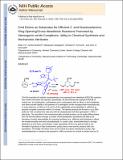| dc.contributor.author | Yu, Miao | |
| dc.contributor.author | Ibrahem, Ismail | |
| dc.contributor.author | Hasegawa, Masayuki | |
| dc.contributor.author | Hoveyda, Amir H. | |
| dc.contributor.author | Schrock, Richard Royce | |
| dc.date.accessioned | 2013-11-22T19:53:41Z | |
| dc.date.available | 2013-11-22T19:53:41Z | |
| dc.date.issued | 2012-01 | |
| dc.date.submitted | 2011-11 | |
| dc.identifier.issn | 0002-7863 | |
| dc.identifier.issn | 1520-5126 | |
| dc.identifier.uri | http://hdl.handle.net/1721.1/82559 | |
| dc.description.abstract | The first examples of catalytic enantioselective ring-opening/cross-metathesis (EROCM) reactions that involve enol ethers are reported. Specifically, we demonstrate that catalytic EROCM of several oxa- and azabicycles, cyclobutenes and a cyclopropene with an alkyl- or aryl-substituted enol ether proceed readily in the presence of a stereogenic-at-Mo monopyrrolide-monoaryloxide. In some instances, as little as 0.15 mol % of the catalytically active alkylidene is sufficient to promote complete conversion within 10 min. The desired products are formed in up to 90% yield and >99:1 enantiomeric ratio (er) with the disubstituted enol ether generated in >90% Z selectivity. The enol ether of the enantiomerically enriched products can be easily differentiated from the terminal alkene through a number of functionalization procedures that lead to the formation of useful intermediates for chemical synthesis (e.g., efficient acid hydrolysis to afford the enantiomerically enriched carboxaldehyde). In certain cases, enantioselectivity is strongly dependent on enol ether concentration: larger equivalents of the cross partner leads to the formation of products of high enantiomeric purity (versus near racemic products with one equivalent). The length of reaction time can be critical to product enantiomeric purity; high enantioselectivity in reactions that proceed to >98% conversion in as brief a reaction time as 30 s can be nearly entirely eroded within 30 min. Mechanistic rationale that accounts for the above characteristics of the catalytic process is provided. | en_US |
| dc.description.sponsorship | National Institutes of Health (U.S.) (GM-59426) | en_US |
| dc.description.sponsorship | National Science Foundation (U.S.) (CHE-0923264) | en_US |
| dc.language.iso | en_US | |
| dc.publisher | American Chemical Society (ACS) | en_US |
| dc.relation.isversionof | http://dx.doi.org/10.1021/ja210946z | en_US |
| dc.rights | Article is made available in accordance with the publisher's policy and may be subject to US copyright law. Please refer to the publisher's site for terms of use. | en_US |
| dc.source | PMC | en_US |
| dc.title | Enol Ethers as Substrates for Efficient Z- and Enantioselective Ring-Opening/Cross-Metathesis Reactions Promoted by Stereogenic-at-Mo Complexes: Utility in Chemical Synthesis and Mechanistic Attributes | en_US |
| dc.type | Article | en_US |
| dc.identifier.citation | Yu, Miao, Ismail Ibrahem, Masayuki Hasegawa, Richard R. Schrock, and Amir H. Hoveyda. “Enol Ethers as Substrates for Efficient Z- and Enantioselective Ring-Opening/Cross-Metathesis Reactions Promoted by Stereogenic-at-Mo Complexes: Utility in Chemical Synthesis and Mechanistic Attributes.” Journal of the American Chemical Society 134, no. 5 (February 8, 2012): 2788-2799. | en_US |
| dc.contributor.department | Massachusetts Institute of Technology. Department of Chemistry | |
| dc.contributor.mitauthor | Schrock, Richard Royce | en_US |
| dc.relation.journal | Journal of the American Chemical Society | en_US |
| dc.eprint.version | Author's final manuscript | en_US |
| dc.type.uri | http://purl.org/eprint/type/JournalArticle | en_US |
| eprint.status | http://purl.org/eprint/status/PeerReviewed | en_US |
| dspace.orderedauthors | Yu, Miao; Ibrahem, Ismail; Hasegawa, Masayuki; Schrock, Richard R.; Hoveyda, Amir H. | en_US |
| dc.identifier.orcid | https://orcid.org/0000-0001-5827-3552 | |
| mit.license | PUBLISHER_POLICY | en_US |
| mit.metadata.status | Complete | |
